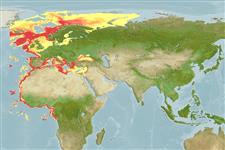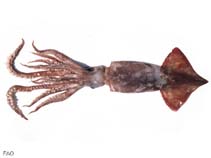Todarodes sagittatus (Lamarck, 1798)
European flying squid| Native range | All suitable habitat | Point map | Year 2050 |

|
| This map was computer-generated and has not yet been reviewed. |
| Todarodes sagittatus AquaMaps Data sources: GBIF OBIS |
Classification / Names Common names | Synonyms | CoL | ITIS | WoRMS
Cephalopoda | Oegopsida | Ommastrephidae | Todarodinae
Environment: milieu / climate zone / depth range / distribution range Ecology
Benthopelagic; depth range 20 - 4595 m (Ref. 81305). Tropical, preferred 20°C (Ref. 107945); 85°N - 6°S, 26°W - 158°E (Ref. 112293)
Distribution Countries | FAO areas | Ecosystems | Occurrences | Introductions
Northeast Atlantic, Mediterranean and the Arctic: Congo Dem Rep to Gibraltar, Mediterranean, Spain to Iceland, to Russian Arctic up to Sakha Republic.
Length at first maturity / Size / Weight / Age
Maturity: Lm 23.2, range 20 - ? cm Max length : 75.0 cm ML male/unsexed; (Ref. 3722); max. published weight: 2.2 kg (Ref. 120431); max. reported age: 2.00 years (Ref. 120431)
Common mantle length ranges between 25 and 35 cm (Ref. 3722). In the Mediterranean Sea no individual was caught in the hauls taken above a depth of 100 m (Ref. 81305). However, studies carried out in Norwegian waters indicated that it occurs in coastal and bank areas 80-200 m and even more superficially at 20-100 m (Ref.81307). It was also observed from the North Atlantic Ridge at a depth of 1947 m (Ref. 81308). Maximum depth from Ref. 1985.
Life cycle and mating behavior Maturity | Reproduction | Spawning | Eggs | Fecundity | Larvae
Members of the class Cephalopoda are gonochoric. Male and female adults usually die shortly after spawning and brooding, respectively. Mating behavior: Males perform various displays to attract potential females for copulation. During copulation, male grasp the female and inserts the hectocotylus into the female's mantle cavity where fertilization usually occurs. Life cycle: Embryos hatch into planktonic stage and live for some time before they grow larger and take up a benthic existence as adults.
Main reference
References | Coordinator | Collaborators
Schneider, W. 1990. (Ref. 417)
IUCN Red List Status (Ref. 130435: Version 2024-1)
Least Concern (LC) ; Date assessed: 10 May 2010
CITES status (Ref. 108899)
Not Evaluated
CMS (Ref. 116361)
Not Evaluated
Threat to humans
Human uses
Fisheries: commercial
FAO - Fisheries: landings | FIRMS (Stock assessments) | FishSource | Sea Around Us
Tools
More information
Trophic Ecology
Ecology
Population dynamics
Life cycle
Distribution
Human Related
Aquaculture profile
Stamps, Coins Misc.
Stamps, Coins Misc.
Outreach
Taxonomy
References
Internet sources
BHL | BOLD Systems | CISTI | DiscoverLife | FAO(Fisheries: ; publication : search) | Fishipedia | GenBank (genome, nucleotide) | GloBI | Gomexsi | Google Books | Google Scholar | Google | PubMed | Tree of Life | Wikipedia (Go, Search) | Zoological Record
Estimates based on models
Preferred temperature
(Ref. 115969): 2 - 14.3, mean 9.3 (based on 570 cells).
Prior r = 0.38, 95% CL = 0.25 - 0.57, Based on 2 data-limited stock assessments.
Nutrients : Calcium = 126 [75, 177] mg/100g; Iron = 4.79 [1.67, 7.92] mg/100g; Protein = 15.5 [13.7, 17.4] %; Omega3 = 0.414 [0.262, 0.566] g/100g; Selenium = 57.8 [48.5, 67.2] μg/100g; VitaminA = 0 μg/100g; Zinc = 1.97 [0.92, 3.02] mg/100g (wet weight); based on nutrient studies.



